Understanding High-Quality Turf Costs: Key Insights
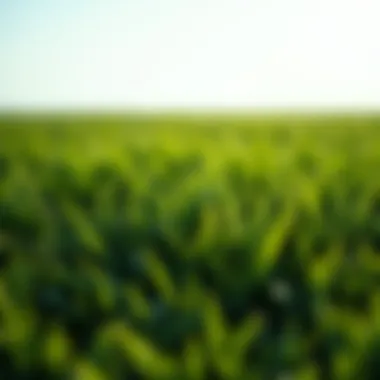
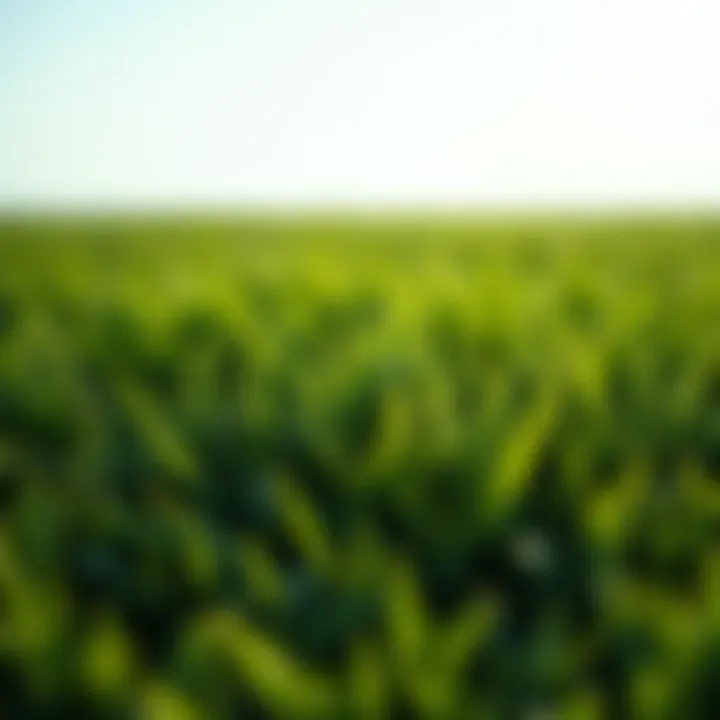
Intro
Understanding the costs associated with high-quality turf requires a comprehensive look at various factors that not only influence price but also determine the overall value and longevity of the investment. Whether you're a homeowner looking to improve your lawn's aesthetic or a commercial landscaper seeking optimal turf options for clients, knowing the ins and outs of turf pricing can save you both time and money. This discussion will help you navigate the labyrinth of turf options and help you make the best decision with regards to quality, installation, and ongoing maintenance.
Turf has evolved significantly over the years, shifting from traditional methods to modern practices that incorporate innovative technologies. This dynamic field requires a keen understanding, as every decision can impact the final outcome of a project. Keep reading as we dissect the industry, highlight key elements affecting costs, and provide insights so you can choose the right path toward a thriving green space.
Prologue to Turf Quality and Cost
When delving into the realm of turf, it's essential to first grasp the intricate relationship between its quality and cost. Understanding the nuances can mean the difference between a lush, vibrant lawn and a patchy, lackluster yard. Turf quality not only influences the aesthetic appeal of an outdoor space but also affects longevity, maintenance needs, and ultimately, the investment required from property owners.
High-quality turf often entails a higher price tag, but the rationale behind this can be illuminating. With various types existing—from natural grass blends to sophisticated synthetic options—each category presents its own costs based on factors like growth conditions and resource inputs. For consumers, recognizing why certain turfs rank as high-quality is crucial: it’s not just grass, it's about durability, resilience, and performance.
Moreover, turf quality is not merely a matter of appearance; it encompasses various components:
- Varieties of grass and how well they adapt to local climates.
- Maintenance needs and the environmental impact of your choices.
- Durability under foot traffic and adverse weather conditions.
The Benefits of Grasping Turf Quality and Cost
Understanding the landscape of turf quality and costs informs buying decisions, assisting you in selecting the best product for your specific needs. It ensures that you spend your resources wisely, avoid costly replacements, and ultimately enhances your outdoor aesthetics. This knowledge is especially relevant for homeowners, landscapers, and agricultural enthusiasts who aspire to create the ideal environment.
In sum, the interplay between turf quality and its associated overall costs cannot be overstated. This foundational knowledge prepares you to explore the various factors that ultimately shape turf pricing in the ensuing sections.
Factors Influencing Turf Pricing
Understanding the costs associated with high-quality turf is pivotal. Various factors come into play in determining these prices, each with its own influence and reasoning. Most importantly, the choice of turf type, quality of ingredients, and geographical factors can cause significant variations in pricing. To make a sensible investment, it is crucial to consider these elements closely.
Type of Turf
Natural Grass Varieties
Natural grass varieties are often celebrated for their aesthetic appeal and natural feel. One of the standout characteristics of these varieties is the ability to blend seamlessly into residential and commercial landscapes, providing an organic touch that synthetic options can rarely replicate. Moreover, these grasses offer environmental benefits, such as improving air quality and providing habitats for wildlife.
While natural grass does require regular maintenance, including mowing and watering, it can provide a lush and soft surface for recreational and leisure activities. A couple of downsides include a higher tendency for pests and diseases and a reliance on seasonal growth cycles, which means it may not perform well in extreme heat or cold.
Synthetic Turf Options
Synthetic turf has gained traction for its low maintenance and durability. One key feature is the resistance to disease and pests, making it a popular choice for high-traffic areas such as sports fields. Additionally, these products often come with long warranties, providing peace of mind to buyers. However, a crucial trade-off is the lack of a natural feel and look; many users miss the soft touch and vibrant appearance of natural grass. Synthetic turf also raises concerns regarding heat retention, as it can become quite hot under direct sunlight, impacting its usability on scorching summer days. Therefore, while synthetic options can be an attractive choice in terms of longevity and upkeep efficiency, they might not tick all the boxes for someone desiring a genuine lawn experience.
Quality of Ingredients
Seed Quality
Seed quality is a fundamental factor influencing the overall cost of turf. Higher quality seeds typically feature greater resilience, quicker growth, and a more robust root system. This means that investment in quality seeds can lead to a healthier lawn that requires less maintenance and fewer resources in the long run. It's also essential to consider that premium seeds can often resist pests and diseases, which save money on pest control and maintenance. On the downside, the initial cost for quality seeds can be higher, which might not appeal to budget-conscious consumers. However, investing upfront can lead to more significant savings over time. Overall, high-quality seeds are a beneficial and wise investment.
Growing Conditions
The growing conditions under which turf is cultivated can drastically impact its pricing. Turf produced in optimal conditions—adequate water, proper pH levels, and rich soil—will generally exhibit greater vitality and resilience. These factors directly affect the turf's durability and overall appearance. On the flip side, if conditions are less than ideal, turf may suffer, leading to a higher likelihood of disease and requiring more resource investments for ongoing care and maintenance. Therefore, understanding and considering these growing conditions is paramount when estimating turf costs and evaluating long-term value.
Geographical Location
Regional Climate Considerations
Every area has its distinct climate, which can seriously affect turf pricing. For example, in regions with harsh winters, certain grass types become a necessity due to their ability to adapt, whereas in warmer climates, drought-resistant varieties might be in higher demand. This regional variability means consumers must choose turf types suited to local climate conditions, influencing not only the purchase price but also ongoing maintenance costs. Choosing the right species for your specific location ensures longevity and performance, helping to offset potential future expenses.
Local Market Dynamics
Local market dynamics, such as competition and demand, also impact turf prices. If multiple suppliers offer similar products, price competition may lead to more attractive options for consumers. Conversely, areas that lack competition might see inflated prices, making it crucial for potential buyers to research their options thoroughly. Additionally, regional trends may lead to price surges in peak season or during specific events, so staying informed about local dynamics is necessary for making cost-effective choices. By understanding this aspect, buyers can strategically time their turf purchases for better pricing.
Cost Breakdown of High-Quality Turf
Understanding the cost associated with high-quality turf is vital for anyone looking to invest in or cultivate a lush, green landscape. When one breaks down costs, it becomes clearer how various factors contribute to the overall expense. This breakdown allows potential buyers to budget accordingly and make more informed choices.
Key aspects of the cost breakdown include price per square foot, installation costs, and additional expenses related to turf maintenance. Each element interacts with others, reinforcing the idea that while high-quality turf might come with a steeper price tag up front, the long-term benefits can warrant the investment.
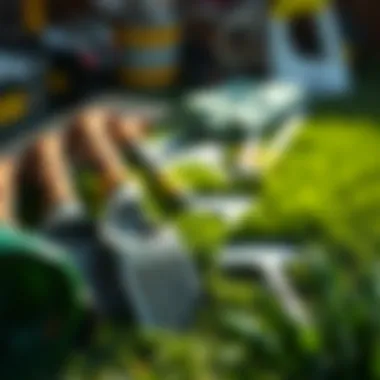
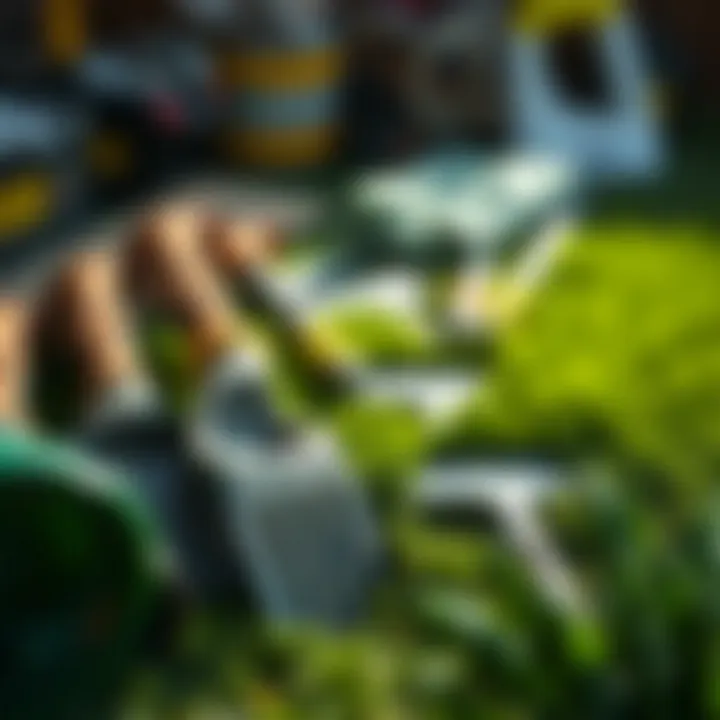
Per Square Foot Pricing
When pricing turf, understanding the cost per square foot is essential. This figure typically serves as the starting point for consumers and contractors alike when assessing overall turf expenses. The price per square foot can vary widely based on several factors, including the type of turf selected, the quality of materials, and regional pricing fluctuations.
Depending on the turf variety, costs can range from affordable natural grass at about $0.50 to high-end selections, such as Kentucky bluegrass or premium synthetic options, soaring to $5.00 or more per square foot. Hence, knowing precisely what fits within your budget allows for better strategic planning without compromising on quality.
Installation Costs
Installation represents a significant part of the total expense and encompasses both labor and equipment.
Labor Expenses
Labor expenses can be a daunting factor when considering turf installation. Professional landscapers tend to charge based on the number of hours worked or a flat fee for the entire project. On average, labor costs can hit anywhere from $1.00 to $2.50 per square foot, depending on the area's labor market and the complexity of the installation.
Inexperienced hands might lead to subpar outcomes, so employing skilled labor can be seen as a worthy investment. When turf is installed correctly, it thrives better and reduces the need for excessive maintenance over time.
However, there can be pitfalls, as high labor costs may deter some people from opting for professional installation, leading them to make less informed choices.
Equipment Rental
Equipment rental can further add to installation costs. Tasks such as leveling the soil or laying the turf sheets require specialized machinery, which may not be readily available to most homeowners. Renting heavy equipment, like turf rollers and aerators, often costs between $50 to $200 per day, depending on the tools involved and the rental location.
Selecting rental equipment can be advantageous because it enables one to undertake a more professional installation without purchasing costly machinery.
Nevertheless, relying on rented equipment may lead to delays or additional expenses if tools are needed longer than expected. Therefore, thorough planning and consideration of these variables are crucial to maximize efficiency and reduce costs during installation.
Additional Expenses
Beyond the initial purchase and installation, ongoing maintenance must also be factored into the total investment. These additional expenses can sometimes go unnoticed but are integral to keeping the turf looking its best.
Fertilization and Maintenance
Regular fertilization and maintenance can range from $20 to $100+ annually, depending on turf type and regional soil conditions. This process ensures that the turf remains healthy and vibrant throughout the seasons. High-quality fertilizers promote deep root growth and resistance to pests.
Additionally, if your turf requires specific nutrient levels, the extra investment in appropriate fertilizers pays off over the long term.
Watering Systems
Watering systems play a pivotal role in maintaining turf health. Installing a sprinkler system can range from $500 to $2,500 based on the size of the area and intricacy of the design. Ongoing costs for water can inflate with inefficient systems, but proper irrigation ensures lush, green growth without unnecessary water use.
A quality watering system enhances convenience and consistency in turf care. However, if not maintained or monitored, these systems can lead to increased expenses and water waste. Hence, understanding these costs helps create a more informed investment in the long run.
In summary, a comprehensive look at the cost breakdown of high-quality turf should include per square foot pricing, installation costs—including labor and equipment rental—and the often-overlooked additional expenses stemming from maintenance. By taking a holistic view of these costs, buyers can make calculated decisions that promote not just the immediate aesthetic values but also the long-term viability of their turf investment.
Key takeaway: Understanding the full scope of costs associated with high-quality turf is essential for making informed decisions, helping you achieve both beauty and longevity in your landscape.
Comparative Analysis of Turf Types
The choice between different turf types can feel like choosing between apples and oranges, but knowing the distinct characteristics of each can give buyers much-needed clarity. This comparison is crucial for landowners, farmers, and enthusiasts alike because it directly impacts both initial investments and long-term satisfaction. When examining turf, factors like maintenance, environmental conditions, and purpose should always be front of mind. This deep dive isn't just about aesthetics; it’s about evaluating practicality and sustainability too.
Natural Grass vs. Synthetic Turf
Natural grass and synthetic turf are often pitted against one another in a heated battle of preferences. On one hand, natural grass brings the charm of life. It offers a genuine ecosystem, inviting nature's tiny creatures while releasing fresh oxygen into the atmosphere. For sports fields or residential lawns, the beauty of vibrant green grass can hardly be overstated. The soft texture and adaptability to varying climates are other alluring factors that draw people to it. Additionally, natural grass has the capacity for self-renewal through reseeding, which can make it more ecologically sustainable in certain conditions.
However, natural grass does have its pitfalls. The watering and fertilization needs can be daunting, especially in dry seasons or when pest problems arise. Regular mowing can become tiresome, not to mention the reliance on weather conditions which can alter the visual appeal seemingly overnight.
On the flipside, synthetic turf screams convenience. It stands resilient against heavy usage without the usual wear and tear, often touted as extremely durable. Homeowners and facilities that want a low-maintenance option may find synthetic turf appealing, especially when it comes to saving on water and chemical expenses. However, this convenience comes at a price—not only financially, but also in terms of environmental impact. While synthetic options may not need watering, they are made of plastic fibers which can create waste problems when they reach the end of their lifespan.
When weighing both, consider the purpose. For instance, residential yards accommodate both kids playing and pets running about, where natural grass may fit the bill. In contrast, a commercial or heavily used sports field might benefit more from the resilience of synthetic options. So, while it may look gorgeous, it’s more about how each type aligns with your expectations and lifestyle.
"Choosing turf isn't just a decision; it's setting the stage for experiences that grow and impact our lives."
Cost vs. Longevity
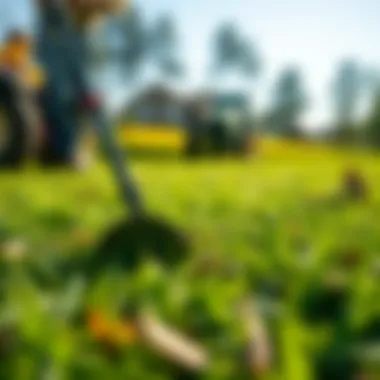
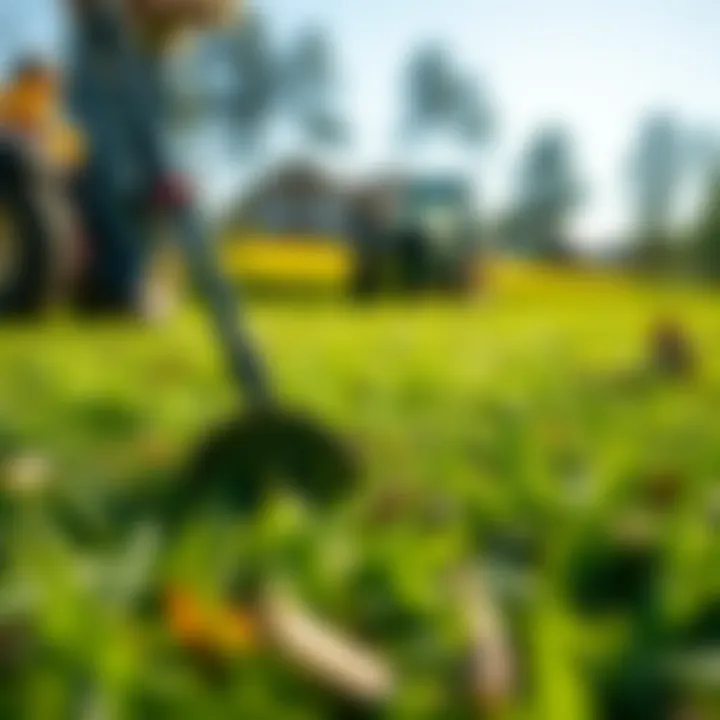
In this world, the price tag on any turf can’t just be considered at face value. High-quality turf—no matter the type—comes with its own series of costs that can shift over time. With natural grass, buyers often face ongoing expenses for maintenance to preserve lushness—a reality accompanying the joy of having real green underfoot. Seasonal care such as mowing, fertilization, aeration, and pest management are inevitable. All these costs can add up, especially when unexpected conditions arise.
Synthetic turf, while appearing pricey upfront, tends to have lower maintenance costs. The life expectancy can range from 10 to 15 years, far exceeding most natural options. However, buyers should remain cautious; although you save on some upkeep, initial expenses might still steepen the budget. Plus, the illusion of zero upkeep fades quickly if one considers longevity against disposal costs.
In simpler terms:
- Natural Grass
- Synthetic Turf
- Initial Cost: Moderate, usually less than synthetic
- Maintenance Cost: Regular, often unpredictable, can be high in dry seasons
- Longevity: Variable, dependent on climate and care
- Initial Cost: High
- Maintenance Cost: Lower, but with considerations regarding disposal and eventual replacement
- Longevity: 10-15 years on average, but dependent on usage
Both options carry their benefits and drawbacks, making it vital to assess how well the product aligns with your needs and investment forecasts. If you’re prepared to put in the ongoing effort, natural grass may offer rewards beyond appearances, while synthetic turf may serve as a long-term, hassle-free solution despite its upfront cost. Understanding these factors makes it easier to make informed decisions, ensuring you’ve chosen the right turf for your circumstances.
Long-Term Value Considerations
When pondering over the costs associated with high-quality turf, it’s essential to look beyond the initial expenditure. Long-term value considerations encompass various aspects that can significantly influence your decision. Especially for those in agriculture or landscape management, understanding the holistic picture helps in making prudent investments that yield fruitful returns.
Durability and Lifespan
High-quality turf is often synonymous with durability and extended lifespan. The choice of turf species plays a pivotal role in how long the grass will last under various conditions. For instance, warm-season grasses, like Bermuda, thrive in hot climates and can withstand wear from heavy foot traffic, making it a favorite for athletic fields. Conversely, cool-season grasses, such as Kentucky Bluegrass, are better suited for cooler regions but can suffer during intense heat.
Regular maintenance practices can also extend the lifespan of turf. This includes appropriate watering, aeration, and fertilization. Investing in quality turf often means lower replacement costs, as high-quality options can last significantly longer than cheaper, lower-grade varieties. People who take care of their turf can expect to see 15-25 years of viability out of certain selections if tended to properly.
"Investing in durable turf can mean less frequent replacements, leading to better cost savings over time."
Aesthetic Impact
While performance and durability are paramount, the aesthetic appeal of high-quality turf cannot be understated. A lush, green lawn or field contributes not only to the beauty of a property but also enhances its overall value. Curb appeal is a vital factor for homeowners and businesses alike. For instance, properties with well-manicured lawns can command higher sale prices and attract potential buyers more effectively.
Moreover, the visual qualities of high-quality turf can create inviting environments for social activities, making areas more socially engaging. Whether it’s a public park or a residential yard, the look of the grass can influence how people perceive and interact with the space. A beautifully maintained lawn fosters community vibes, providing spaces for families to gather or communities to unite.
Buying Options for Turf
Understanding the various buying options for turf is crucial for anyone looking to invest in high-quality grass. The choices individuals make can significantly impact both budget and long-term satisfaction. From DIY installations to professional contracting, and choosing between local or online suppliers, each option holds distinct advantages and challenges. Thus, this section aims to shed light on these aspects, enabling informed decision-making.
Direct Purchase vs. Contracting
When it comes to acquiring turf, buyers typically face the decision of whether to purchase directly or to go through a contractor. Direct purchasing involves obtaining turf from a nursery or a grower, which often allows for cost savings. Homeowners can visit the site, choose the variety they want, and negotiate directly with the seller. This route provides greater control over selection but requires some know-how about turf quality and installation techniques.
On the flip side, opting for contracting can relieve individuals of the heavy lifting and technical aspects of installation. Professional contractors can ensure that the turf is laid correctly, which can be crucial for the longevity and health of the grass. Furthermore, if issues arise, a reliable contractor can offer warranties and support, which might not be available when making a direct purchase.
Online vs. Local Suppliers
The choice between online suppliers and local suppliers can profoundly influence a turf buyer's experience.
- Online suppliers often offer a larger inventory, specializing in various grass types, and providing detailed descriptions, which can help prospective buyers understand what they are investing in.
- Additionally, shopping online can save time and sometimes even provide cheaper prices due to lower overhead costs.
However, there are certain drawbacks. Without local visuals and the ability to physically inspect the turf, buyers may face risks with quality or misrepresentation. Moreover, shipping issues can affect timing or condition upon arrival, especially if the turf is intended for immediate installation.
Conversely, local suppliers present an opportunity for hands-on engagement. Buyers can see the turf in person, assess its quality, and avoid potential shipping delays. Local businesses may also offer expertise tailored to regional climate conditions. However, the selection might be limited compared to online options, and prices can be slightly higher due to overhead costs associated with maintaining a physical store.
In summary, the buying strategy one chooses impacts not just the initial investment but also the user's overall satisfaction with the product. Weighing the pros and cons of each method allows buyers to hit the ground running, ensuring their turf investment leads to lush, green results.
Impacts of Seasonal Demand on Turf Prices
Understanding seasonal demand is crucial when analyzing turf prices. As any savvy buyer knows, the time of year can significantly influence what you pay for high-quality turf. Seasonal variances aren't just numbers on a chart; they affect everyone in the supply chain, from the growers to the end consumers. For those looking to invest intelligently in turf, grasping these dynamics can spell the difference between a wise purchase and an inflated expense.
Seasonal Trends in Turf Purchases
Certain times of the year see a surge in purchases. Typically, spring is the busiest season for turf sales. There’s a palpable excitement as homeowners and businesses alike look to green up their lawns and fields. This season tends to hear the sound of lawnmowers roars in greater frequency as traffic at garden centers reaches its peak. The demand arises from a mix of aesthetic aspirations and functional needs. After all, no one wants a brown, lifeless yard when the sun is shining bright.
On the flip side, fall can be a slow period for turf sales. People often shift their focus to winter preparations, leaving the turf market ripe for deals. Suppliers may lower prices to unload remaining stock before winter puts everything on ice. For astute buyers, this can be a golden opportunity to snap up quality turf at a reduced price.
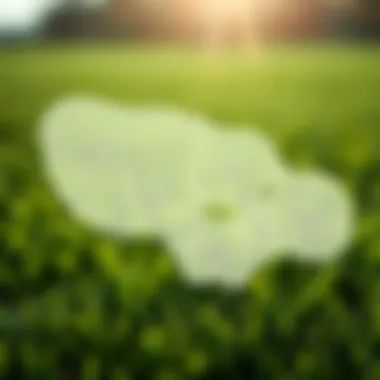

Here are some noteworthy points on seasonal trends:
- Spring Rush: Homeowners eager to enhance their landscapes drive prices up, often leading to higher upfront costs.
- Fall Discounts: Prices can drop significantly, making it an advantageous time for budget-conscious buyers.
- Geographic Variations: Some regions may experience different seasonal peaks based on climate and local events.
Supply Chain Influences
The interplay between supply and demand is critical in determining turf prices. A blooming demand season can mean higher prices if supply doesn't keep pace. Conversely, during quieter months, suppliers may find themselves with excess stock, pushing them to offer attractive pricing to clear their inventory.
Supply chain logistics play a significant role too. Factors include:
- Shipping and Transportation Costs: Fuel prices and truck availability can impact delivery costs, which may indirectly affect retail prices.
- Growing Conditions: Adverse weather can affect crop yields. If a particularly harsh winter or dry summer stifles production, expect prices to climb when demand surges.
- Supplier Relationships: Local suppliers may have varying amounts of stock, depending on previous seasonal trends. Those with strong relationships and reliable sources may find more stable pricing, while others might struggle with fluctuating costs.
In closing, the seasonality of turf purchases and the complexities of the supply chain are essential elements in predicting and understanding turf costs. Buyers who keep an eye on these trends can better navigate the market, potentially saving money while investing in high-quality turf for their needs.
Evaluating Quality Assurance in Turf
When considering the investment in high-quality turf, the examination of quality assurance ranks among the most pivotal factors. Quality assurance in the turf sector encompasses various elements that ultimately shape the reliability and performance of the turf you choose. These aspects not only assure you of the product’s excellence but also influence your long-term satisfaction and the returns from your investment.
By understanding these quality assurance processes, buyers can navigate through a multitude of options, distinguishing premium turf from lesser qualities. This guidance becomes even more crucial considering the myriad of turf types available today—natural, synthetic, and hybrid varieties all presenting unique challenges and benefits.
Certification Standards
One of the cornerstone elements of quality assurance is the certification process. Certification involves rigorous testing and evaluation, ensuring that turf products meet specific industry standards. Not every turf that claims to be 'high-quality' carries these stamps of approval, making it vital for consumers to look beyond surface-level qualities.
Some certifications to consider include:
- USDA Organic: For natural turfs, organic standards confirm that no synthetic fertilizers or pesticides are involved in the growing process.
- ASTM Certification: For synthetic turfs, compliance with ASTM standards is crucial. This certification indicates that the materials used are safe and meet performance benchmarks.
- Sustainable Turf Certification: Particularly relevant for eco-conscious buyers, sustainable certifications highlight turf that is environmentally friendly and produced through sustainable practices, ensuring minimal negative impact on the surrounding ecosystem.
Having turf that adheres to these certification standards not only assures buyers of quality but can lead to significant long-term cost savings by reducing maintenance costs and promoting a healthier environment.
Supplier Reputation
Equally vital is the reputation of the supplier. A reliable supplier acts as a linchpin in your turf purchasing experience, directly influencing product quality and customer service. When buying turf, consider reaching out to past customers or looking for reviews on platforms such as Reddit, where discussions about turf suppliers and products can provide invaluable insights.
Some factors to assess supplier reputation include:
- Years in Business: Established suppliers with a proven track record tend to offer more reliable products.
- Customer Service: How a supplier addresses issues and queries can make or break your experience. Good customer service often indicates a commitment to quality.
- Warranties and Guarantees: Suppliers who stand by their product typically offer warranties, ensuring your investment is protected and giving you peace of mind.
"The reputation of your turf supplier often serves as a forecaster for the quality of the turf you’ll receive.”
In summary, evaluating quality assurance in turf requires careful consideration of established certification standards and the reputation of suppliers. By focusing on these aspects, buyers not only secure a turf product that meets their needs but also contribute to the overall health of their landscapes and environments. Buyers who invest time in evaluating these elements often find their choices yielding the greatest satisfaction and value.
Ending: Making Value-Driven Turf Investments
As we wrap up this extensive exploration of high-quality turf, it is crucial to underscore the importance of making informed investments in this area. The costs associated with turf—whether synthetic or natural—extend far beyond the initial purchase price. By comprehensively understanding various elements of turf quality and pricing, buyers can ensure they are not just spending money but are investing in a long-term asset that meets their specific needs.
Investing in high-quality turf translates into better aesthetics, durability, and performance. Here are some specific elements to consider:
- Initial vs. Long-Term Costs: The initial price might seem hefty, but consider maintenance and replacement costs over time. High-quality turf often requires less upkeep, potentially saving more money in the long run.
- Versatile Applications: Understanding the different types of turf and their respective uses can help tailor your investment to your needs. See if a hardy, drought-resistant variety may fit better in your climate zone.
- Local Conditions: Factors like soil quality, climate, and local wildlife should influence your choice. Choosing the suitable turf variety adapted to your environment can drastically improve its longevity and health.
Value-driven investments hinge on two critical aspects: prioritizing quality and anticipating future needs. If a customer prioritizes these factors, they can avoid falling into the trap of opting for the cheapest option available. Every dollar spent should reflect both quality and longevity, ensuring that the turf serves its intended purpose efficiently.
An investment in high-quality turf is not just an expense; it's a commitment to creating and maintaining an attractive, functional space for years to come.
Key Takeaways
To summarize our discussion, here are the critical takeaways to remember:
- Quality Matters: Always prioritize quality over initial cost. High-quality turf often leads to lower long-term maintenance expenses.
- Do Your Homework: Research different types of turf suited to your region and specific use cases.
- Consider Long-Term Value: Think about how the turf will hold up under variable climates and usage scenarios to assess its overall value.
Investing time into understanding these elements will yield much better outcomes, ensuring your turf remains lush and vibrant through all seasons.
Future Trends in Turf Quality and Pricing
Looking ahead, several emerging trends are shaping the turf industry that buyers should keep an eye on.
- Sustainability: More consumers are leaning toward eco-friendly turf options, particularly synthetic ones that conserve water and reduce chemical usage, which can ultimately lessen environmental impact.
- Technological Advancements: Innovations in turf technologies, such as smart irrigation systems and advanced growing techniques, are becoming mainstream. These advancements could improve turf health while optimizing water usage and care routines.
- Market Dynamics: As more consumers become aware of turf quality nuances, the push for transparency in pricing and quality assurance will likely rise. This demands that turf providers stay on their toes, ensuring consistently high-quality offerings.
Staying informed about these trends will enable you as a buyer to make decisions that are not only budget-friendly but also strategically sound, ensuring your turf investments remain robust in an evolving market.



